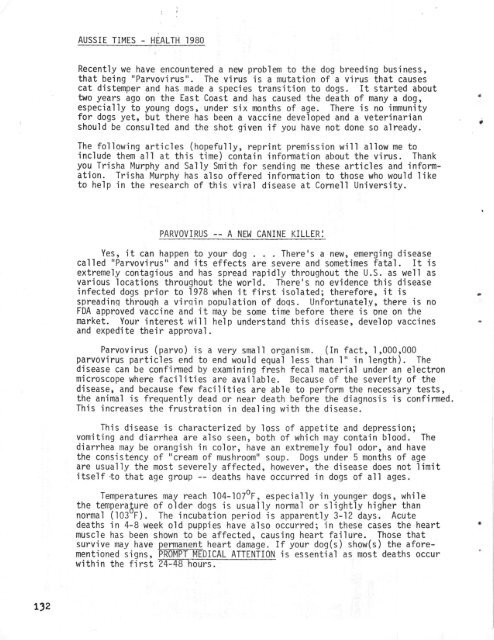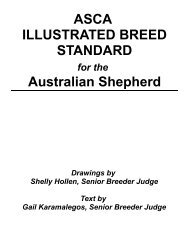1980-11
1980-11
1980-11
Create successful ePaper yourself
Turn your PDF publications into a flip-book with our unique Google optimized e-Paper software.
AUSSIE TIMES - HEALTH <strong>1980</strong><br />
Recently we have encountered a new problem to the dog breeding business,<br />
that being <strong>11</strong> ParvovirUS <strong>11</strong> • The virus is a mutation of a virus that causes<br />
cat distemper and has made a species transition to dogs. It started about<br />
two years ago on the East Coast and has caused the death of many a dog,<br />
especially to young dogs, under six months of age. There is no immunity<br />
for dogs yet, but there has been a vaccine developed and a veterinarian<br />
should be consulted and the shot given if you have not done so already.<br />
The following articles (hopefully, reprint premission will allow me to<br />
include them all at this time) contain information about the virus. Thank<br />
you Trisha Murphy and Sally Smith for sending me these articles and information.<br />
Trisha Murphy has also offered information to those who would like<br />
to help in the research of this viral disease at Cornell University.<br />
PARVOVIRUS -- A NEW CANINE KILLER!<br />
Yes, it can happen to your dog ... There•s a new, emerging disease<br />
ca <strong>11</strong> ed <strong>11</strong> Parvovi rus <strong>11</strong> and its effects are severe and sometimes fata 1. It is<br />
extremely contagious and has spread rapidly throughout the U.S. as well as<br />
various locations throughout the world. There•s no evidence this disease<br />
infected dogs prior to 1978 when it first isolated; therefore, it is<br />
spreadinq throuqh a virqin population of doqs. Unfortunately, there is no<br />
FDA approved vaccine and it may be some time before there is one on the<br />
market. Your interest will help understand this disease, develop vaccines<br />
and expedite their approval.<br />
Parvovirus (parvo) is a very small organism. (In fact, 1,000,000<br />
parvovirus particles end to end would equal less than 1 <strong>11</strong> in length). The<br />
disease can be confirmed by examining fresh fecal material under an electron<br />
microscope where facilities are available. Because of the severity of the<br />
disease, and because few facilities are able to perform the necessary tests,<br />
the animal is frequently dead or near death before the diagnosis is confirmed.<br />
This increases the frustration in dealing with the disease.<br />
This disease is characterized by loss of appetite and depression;<br />
vomiting and diarrhea are also seen, both of which may contain blood. The<br />
diarrhea may be orangish in color, have an extremely foul odor, and have<br />
the consistency of <strong>11</strong> Cream of mushroom <strong>11</strong> soup. Dogs under 5 months of age<br />
are usually the most severely affected, however, the disease does not limit<br />
itself to that age group -- deaths have occurred in dogs of all ages.<br />
Temperatures may reach 104-l07°F, especially in younger dogs, while<br />
the temperabure of older dogs is usually normal or slightly higher than<br />
normal (103 F). The incubation period is apparently 3-12 days. Acute<br />
deaths in 4-8 week old puppies have also occurred; in these cases the heart<br />
muscle has been shown to be affected, causing heart failure. Those that<br />
survive may have permanent heart damage. If your dog(s) show(s) the aforementioned<br />
signs, PROMPT MEDICAL ATTENTION is essential as most deaths occur<br />
within the first 24-48 hours.<br />
•<br />
•<br />
132



